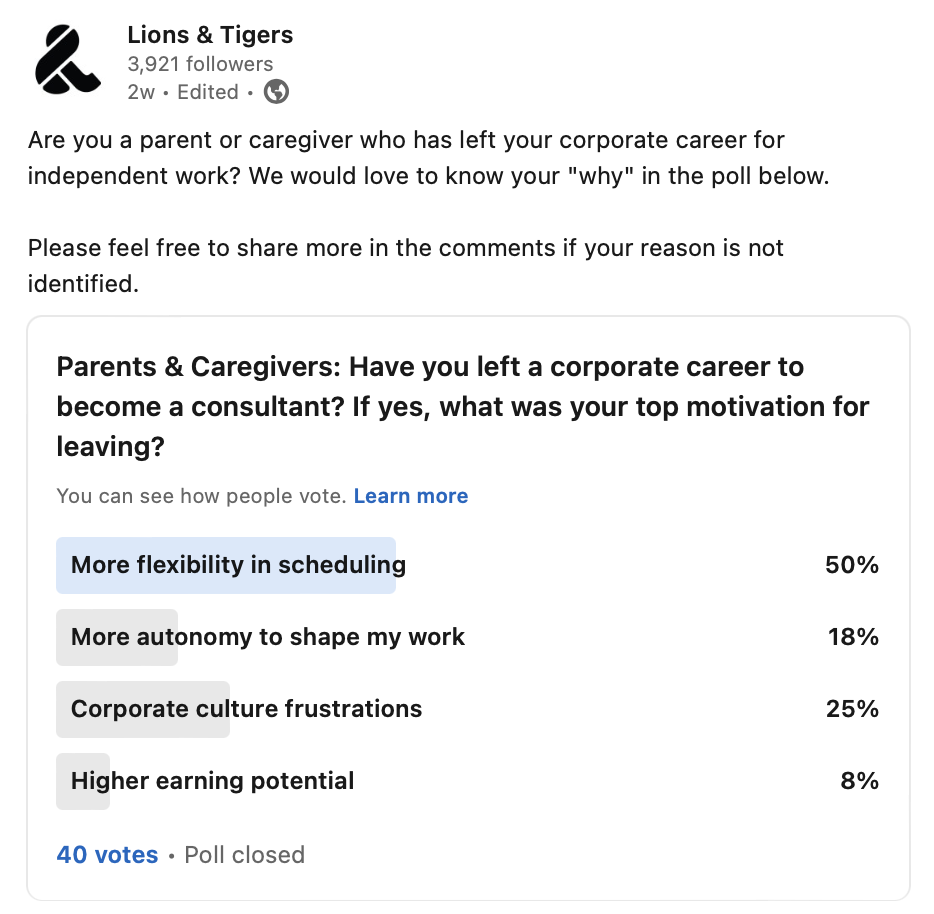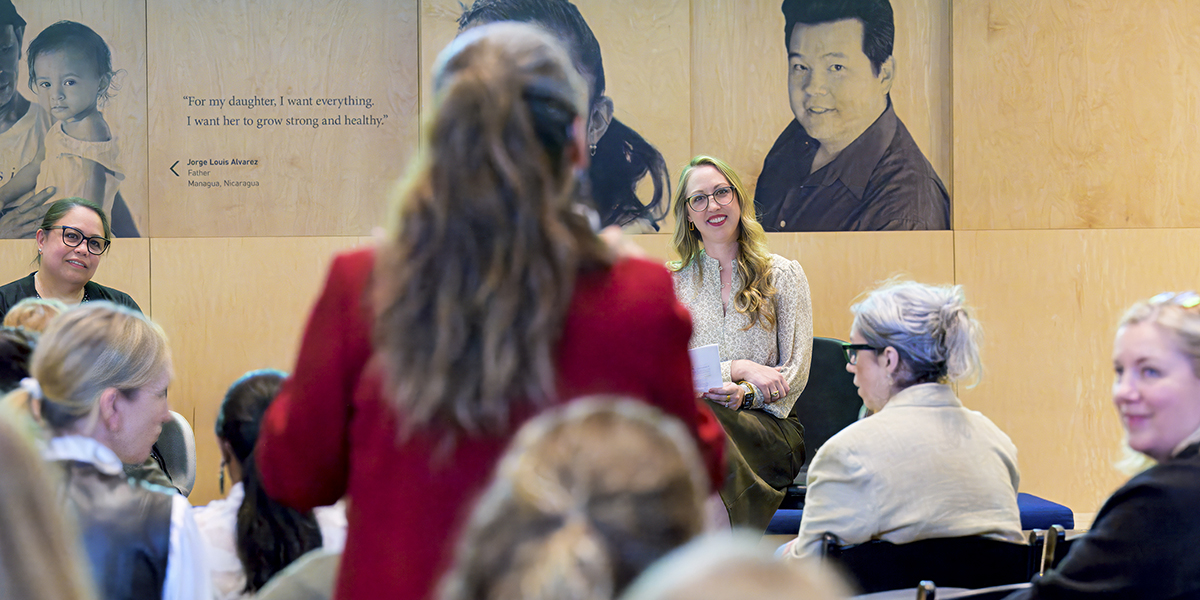Emerging research on the post-pandemic workforce reveals a stark reality: Employees not only prefer flexibility, but they require it. In fact, many are willing to give up their jobs to find it. This is especially true for caregivers, which make up the fastest-growing employee group today.
Seeking answers to high attrition rates? Take note. Working parents and caregivers stand out among the record number of employees leaving their jobs or considering doing so. According to a Harvard Business School study, 73% of all employees manage some level of caregiving responsibility, and it’s not just parents caring for young children. Around 53% of employees ages 40-49 and 36% of all workers 40 and older provide care for another adult, per the AARP.
Equally alarming for employers focused on deriving benefits from diversity, equity, and inclusion efforts is the fact that non-white parents are leaving at higher rates. In the latest McKinsey research, fully half of non-white fathers surveyed said they planned to leave their jobs, and non-white mothers are planning to leave at higher rates than white mothers (Exhibit 1).
These emerging trends come on the heels of other disturbing trends, including the fact that women leaders are leaving at the fastest rate in the past decade (McKinsey, 2022). Women in tech could soon experience drop-out rates of up to 70%, according to Accenture in pre-pandemic 2019.
Flexibility and Open Communication Are Anti-Attrition Antidotes.
When McKinsey asked employees what their employers could do to entice them to stay, a commitment to real flexibility topped the list, though a few other common denominators included a desire for increased project variety, opportunities for learning and skills development, more autonomy and freedom to make decisions, higher pay and earning potential, as well as improving the corporate culture.
Flexible working arrangements can make all the difference for employees balancing work responsibilities with caregiving responsibilities, though some would-be employees have turned to self-employment roles like consulting, where they have maximum control over their schedules.
In fact, independent workers are the fastest-growing segment of the U.S. labor force and are projected to eclipse the number of U.S. employees within 5 years, according to McKinsey. In 2022, 58 million American adults, about 36% of the American workforce, identified as independent workers.
When we asked consultants who have left corporate careers for independent work why they left, flexibility came out on top.

Lions & Tigers Consultant Perspective
 Nicole Pargoff, a business manager consultant with Lions & Tigers has been consulting since 2008. She says the inherent scheduling flexibility of her role has been invaluable as she navigates an evolving situation outside work that has her periodically commuting out of state to provide caregiving duties to her mother, who was diagnosed with Alzheimer’s in 2023. “There’s a layer of complexity to my schedule because of this kind of remote caregiving,” she says. “And it’s not something easily accommodated in traditional roles.”
Nicole Pargoff, a business manager consultant with Lions & Tigers has been consulting since 2008. She says the inherent scheduling flexibility of her role has been invaluable as she navigates an evolving situation outside work that has her periodically commuting out of state to provide caregiving duties to her mother, who was diagnosed with Alzheimer’s in 2023. “There’s a layer of complexity to my schedule because of this kind of remote caregiving,” she says. “And it’s not something easily accommodated in traditional roles.”
Pargoff notes a contrast she’s seen in the way employers handle caregiving for children versus other adults. “I love that parenthood is a priority in the workplace, but it’s also important to acknowledge that there are other things people need to care for in our personal lives,” she says. “If I need to be responsive to my mom, take her to an appointment, or be off-line for a couple of hours, that’s something an employer can accommodate in the same way they are accommodating to parents with children.”
These days, Pargoff is open and honest with clients about her schedule, including sharing information about her mother’s diagnosis. “And I’ve found a community,” she says. “I think it’s beneficial to just be honest with your coworkers — don’t be afraid to do that. You’re trying to do the right thing for someone you care about, but it’s an emotional toll and it’s a time commitment. When you’re honest about what you and your family are going through, people can help you. Ultimately, what your colleagues want to do is support you, and you’re only going to find that support as a caregiver by being transparent.”
Why Should Employers Care About Attrition?
Effective employers know that replacing workers is far more costly, in both time and financial resources, than nurturing existing employee relationships. When it comes to losing under-represented voices, high attrition rates can quickly lead to an innovation drain. According to research conducted by Accenture:
- Companies with more diverse teams have 19% high revenue due to innovation
- Companies boasting diverse workforces earn 2.5 times higher cash flow per employee
- Inclusive teams are up to 35% more productive
Ultimately, as under-represented voices migrate faster out of the labor pool, companies are losing highly valuable employees, many of whom are leaving because they can’t find the necessary flexibility to tend to their caregiving roles. In fact, a Harvard Business School study revealed that U.S. businesses lose $35 billion annually from failing to attract, support and retain workers who have caregiving responsibilities.
Is there a Win-Win Solution for Maintaining Caregiver Employees?
Beyond seeking flexible work arrangements, there are several actionable steps employers can take to keep from losing talented employees who feel forced to choose between vital caregiving roles and their jobs.
Modernize Caregiver-Focused Company Policies
Develop a strong human resource policy related to caregiver accommodation and put it in writing. Focus on key elements like flex time, childcare support, paid family leave and support for caregivers who care for other adults. McKinsey reports that the most successful companies listen closely to their employees, soliciting feedback and crafting responses tailored to specific needs.
Adopt a Blended Workforce Model
Consider a blended workforce model, where independent/contract workers team up with regular employees to complete projects and achieve business objectives. (We have a whole series on how to implement a blended workforce here that you can check out.) Opening the door to these partnerships can help stave off burnout by giving stressed employees much needed support — all while providing opportunities to those who have chosen consulting roles.
Lions & Tigers Consultant Perspective
 When Alisha Sanvicens, Lions & Tigers Communications & Program Management Consultant, was ready to return to the working world as a new mother, she steered clear of going back to work full-time. Having worked for an extended period of time in the United Kingdom, she says she wanted to be able to replicate the opportunities modeled for her there for working mothers, where 9-12 months maternity leaves are common. “My body and mind needed more than 12 weeks to recover and get back to work,” she says. “I was also no stranger to burnout and could see the writing on the wall of going back full-time, even through the post-partum fog.”
When Alisha Sanvicens, Lions & Tigers Communications & Program Management Consultant, was ready to return to the working world as a new mother, she steered clear of going back to work full-time. Having worked for an extended period of time in the United Kingdom, she says she wanted to be able to replicate the opportunities modeled for her there for working mothers, where 9-12 months maternity leaves are common. “My body and mind needed more than 12 weeks to recover and get back to work,” she says. “I was also no stranger to burnout and could see the writing on the wall of going back full-time, even through the post-partum fog.”
It’s no surprise that flexibility played an enormous role in Sanvicens’ decision. “I was fortunate to be offered a role by my previous manager for a part-time position that was flexible and allowed me to do great work with great people,” she recalls. After her next child was born, she was able to find another flexible work arrangement and eventually, a flexible role with Lions & Tigers.
“Managing caregiving and work is a known issue for all parents,” Sanvicens notes. “Without wider societal systems in place to better support working mothers and fathers, it’s been a choose-your-own adventure, creating my own way, and trusting the path will appear. I also acknowledge that working flexibly is not an option for everyone, but I hope that changes.”
Sanvicens says companies like Lions & Tigers that normalize flexible work arrangements make it “much, much easier for people like me to find the sweet spot of work inside and outside the home. The community they’ve built of people who want to work hard in a way that works for them and their life circumstances has been incredibly empowering and an honor to be a part of.”
Benefit from a Blended Workforce Powered by Lions & Tigers
Lions & Tigers partners with organizations like yours to co-design workforce solutions aligned to your key outcomes. You’ll benefit from the right mix of full- and part-time experts who are poised to meet the needs of short- and long-term engagements. Our unique model allows organizations to tap into the immense experience of strategic doers, fractional executives and specialists, simultaneously.
Organizations like Lions & Tigers offer a dual benefit: We can help you retain the valuable talent you’ve already invested in, while offering fresh perspectives and expertise to enhance your team and achieve your business goals.
Learn more at https://lionsandtigers.com/solutions/ and set up a free consultation today.








0 Comments